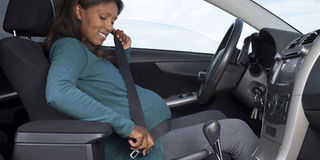Be careful with seat belt during pregnancy

What you need to know:
- It may be tricky to buckle up now that you are pregnant.
- You might be thinking of forgoing a seat belt because it seems uncomfortable or because you think it could smash the baby. But do not even think about it.
For the first six months of her second pregnancy, Anita Mpairwe always drove while wearing a seat belt. However, as the pregnancy advanced into the seventh month, she could no longer wear the seat belt because it was becoming uncomfortable and difficult to endure.
“I stopped wearing the seat belt because much as I knew it was safe for me to wear it, I could not drive comfortably with it anymore. I felt like it was cutting short my oxygen and I could barely breathe,” Mpairwe recalls.
Shanita Nassuna, an expectant mother, says wearing a seat belt is dependent on how long you will be driving. “As your pregnancy progresses, you may find it uncomfortable to sit in the car for long periods. So if you need to make a long journey, plan to have short breaks about every 90 minutes to prevent your ankles or legs swelling and cramping. A cushion or foam wedge in the small of your back may help to prevent backache,” Nassuna says.
How it should be worn
Dr Umarashid Guloba, a doctor at Makerere University Business School Health Centre, says the safest way is to wear your seat belt below the stomach, commonly known as the hip or lap belt.
“The seat belt should not be worn across the stomach. It should be way below the stomach on the thighs and the one that holds the upper part of the body should be worn above the stomach at the shoulder level. It should be above the stomach running through the breasts,” Dr Guloba advises. “If you do not wear it according to these guidelines and you unfortunately jerk forward while driving, you are likely to hurt the unborn baby and yourself if the stomach hits the steering wheel. In a worse situation, it can cause internal bleeding and lead to death of your unborn baby or yourself,” he adds.
Though seat belts cause a certain degree of discomfort, Guloba says wearing one is for your own good as there is no traffic law that prohibits expecting mothers from wearing seat belts.
He is, however, quick to caution against wearing your seat belt across the stomach as it would then cause pressure and discomfort to the unborn child.
Plan for your journey
Dr Henry Musinguzi, a general practitioner at Nyakibaale Referral Hospital, says as your pregnancy progresses, you may at times find it uncomfortable to drive your car for long periods.
“If you intend or plan to hit the road for a long journey, plan to have break intervals of about 15 to 20 minutes for every 90 minutes’ drive to prevent your ankles or legs from swelling and cramping,” Dr Musiguzi explains.
And since driving is sometimes characterised with developing back pains, he recommends using a cushion or pillow or a back rest at your back to prevent backache.
He also observes that in the unfortunate event that you are involved in a car accident, however minor you may consider it to be, schedule an appointment with your doctor or midwife to have an examination to understand if there was no harm or effect on you or the unborn baby through a scan. If any, it can be corrected early to prevent further complicated issues.




